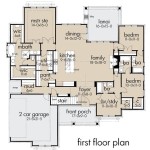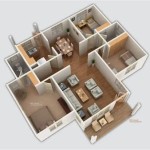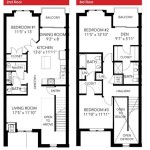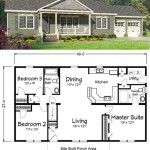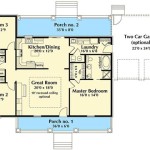3 Bedroom Floor Plan With Dimensions In Meters
Understanding a 3-bedroom floor plan, particularly one with dimensions expressed in meters, is crucial for effective space planning, renovation projects, and even virtual furniture arrangement. The appeal of a three-bedroom layout stems from its versatility; it caters to small families, couples desiring guest rooms or home offices, and individuals seeking extra space for hobbies or storage. Precise dimensional knowledge unlocks the potential of these floor plans, allowing individuals to optimize the use of every square meter and create a functional and aesthetically pleasing living environment.
Accuracy becomes paramount when dealing with architectural plans. Metric measurements, specifically meters, offer a standardized and easily interpretable system for understanding sizes and distances. This article delves into the various aspects of 3-bedroom floor plans measured in meters, highlighting critical dimensions and considerations for maximizing space utilization.
Understanding Key Dimensions in a 3-Bedroom Floor Plan
Several key dimensions define the overall usability and flow of a 3-bedroom floor plan. These dimensions extend beyond the total square meterage and include individual room sizes, hallway widths, and the placement of doors and windows. A comprehensive understanding of these factors is essential for making informed decisions about furniture placement, traffic flow, and overall functionality.
Firstly, the master bedroom’s dimensions are of utmost importance. A typical master bedroom in a 3-bedroom layout often ranges from 3.5 meters x 4.5 meters to 4 meters x 5 meters. These dimensions allow for a comfortable king-size bed, bedside tables, and ample walking space. Consideration should also be given to the inclusion of a walk-in closet, further impacting the overall bedroom size. The master bedroom often includes an ensuite bathroom which, depending on its features (shower, bathtub, toilet, vanity), could measure approximately 2 meters x 2.5 meters to 2.5 meters x 3 meters.
The secondary bedrooms typically exhibit smaller dimensions. These rooms, intended for children, guests, or as home offices, usually range from 3 meters x 3 meters to 3.5 meters x 4 meters. While a queen-size bed might fit comfortably in the larger of these rooms, twin beds are more common for maximizing floor space. Sufficient space for a wardrobe, desk, and chair is also essential to consider during the planning phase.
Living areas, including the living room and dining area, generally account for a significant portion of the total floor space. A combined living and dining area might measure approximately 5 meters x 7 meters to 6 meters x 8 meters. This dimension assumes adequate space for a sofa set, coffee table, entertainment unit, and a dining table with seating for at least four to six people. Open-plan layouts often integrate the kitchen into this area, necessitating careful consideration of spatial relationships and traffic flow.
Hallways and corridors are often overlooked but play a critical role in connecting different areas of the house. A minimum hallway width of 1 meter is generally recommended to allow for comfortable passage, particularly when carrying items. Longer hallways can benefit from slightly wider dimensions to avoid a cramped feeling. Door widths should also be considered; a standard door width of 0.8 meters is typical, though wider doorways may be necessary for accessibility purposes or larger furniture.
Finally, the kitchen dimensions are crucial. A well-designed kitchen in a 3-bedroom house typically falls within the range of 3 meters x 4 meters to 3.5 meters x 4.5 meters. This allows for sufficient counter space, storage cabinets, and room for appliances such as a refrigerator, oven, and dishwasher. The kitchen layout, whether it's a galley, L-shaped, or U-shaped design, will significantly influence the arrangement of these elements and the overall functionality of the space.
Optimizing Space Utilization in a 3-Bedroom Layout
Efficient space utilization is a critical aspect of any floor plan, particularly in a 3-bedroom residence. Effective storage solutions, strategic furniture placement, and thoughtful use of vertical space contribute to a comfortable and functional living environment. Considering these aspects during the planning stage allows for better maximization of the available space.
Built-in storage solutions represent an effective method for maximizing space. These can include built-in wardrobes in bedrooms, shelving units in living areas, and custom-designed storage in hallways. Integrating storage directly into the architectural design reduces the need for bulky freestanding furniture, freeing up valuable floor space. Consider utilizing vertical space by installing shelves that extend to the ceiling or employing lofted storage areas in bedrooms or hallways.
Multi-functional furniture offers another avenue for space optimization. Sofa beds, folding dining tables, and storage ottomans serve dual purposes, allowing for flexibility in how the space is used. In smaller bedrooms, consider using beds with built-in drawers for storing clothing or linens. Similarly, in living areas, coffee tables with lift-top mechanisms can provide hidden storage for remote controls, magazines, or other items.
Strategic furniture placement can significantly impact the perceived size and functionality of a room. In smaller bedrooms, avoid overcrowding the space with unnecessary furniture. Focus on essential items such as a bed, wardrobe, and desk, and arrange them in a manner that maximizes floor space and allows for easy movement. In living areas, consider the flow of traffic and arrange furniture to create a comfortable and inviting space while avoiding obstacles.
Utilizing vertical space effectively is crucial, especially in homes with limited square footage. Installing shelves that extend to the ceiling provides ample storage for books, decorative items, or other belongings. In kitchens, consider using wall-mounted cabinets to maximize storage space without sacrificing counter area. High ceilings can also be utilized by incorporating lofted storage areas or mezzanine levels for additional usable space.
Consider the layout of the bathrooms and laundry areas carefully. Wall-mounted toilets and sinks can save space and create a more streamlined appearance. Stackable washer and dryer units are also helpful for conserving space in laundry rooms. Optimizing these often-smaller spaces contributes to the overall sense of spaciousness within the home.
Accessibility and Circulation Within the Floor Plan
Beyond dimensions and space utilization, accessibility and circulation are paramount in a well-designed 3-bedroom floor plan. These factors influence how easily individuals can move through the house and access different areas, ensuring both comfort and functionality. Consideration should be given to individuals with mobility limitations, as well as the general flow of traffic throughout the living space.
Hallway widths play a crucial role in accessibility. As previously mentioned, a minimum hallway width of 1 meter is generally recommended. However, for individuals using wheelchairs or walkers, a wider hallway of at least 1.2 meters is preferable. This allows for easier maneuverability and reduces the risk of collisions with walls or furniture.
Doorway widths should also be considered with accessibility in mind. A standard doorway width of 0.8 meters may be sufficient for most individuals, but a wider doorway of at least 0.9 meters is recommended for wheelchair access. In bathrooms, consider installing grab bars near the toilet and shower to provide additional support and safety.
The layout of furniture should also prioritize ease of movement. Avoid placing furniture in pathways or creating obstacles that could impede traffic flow. Ensure that there is ample space to move around furniture without bumping into it. Consider the placement of electrical outlets and light switches to ensure they are easily accessible from various points in the room.
Consider the relationship between different areas of the house. A well-designed floor plan should facilitate a smooth and intuitive flow of traffic between the living area, bedrooms, kitchen, and bathrooms. Avoid creating bottlenecks or dead-end hallways that could disrupt the flow of movement. The placement of doors and windows can also influence circulation; carefully consider their location to maximize natural light and ventilation while maintaining privacy.
Ramps can be integrated into the design to provide access to different levels of the house for individuals with mobility limitations. If ramps are not feasible, consider the possibility of installing a lift or elevator. These features can significantly improve accessibility and allow individuals to age in place comfortably. The slope of ramps should comply with accessibility standards to ensure safe and easy use.
By addressing these key considerations related to dimensions, space utilization, accessibility, and circulation, individuals can create a 3-bedroom floor plan that is not only functional and aesthetically pleasing but also comfortable and accessible for all occupants. A well-designed home enhances the quality of life and provides a supportive environment for living, working, and relaxing.

Three Bedroom House Concept Pinoy Eplans Plan Small Design

Simple Three Bedroom House Plans To Construct On A Low Budget Co Ke

3 Bedroom House Plans 10x10 Meter 33x33 Feet Pro Home Decors

Small Bungalow House Design And Floor Plan With 3 Bedrooms One Y Home Plans

3 Bedroom Bungalow House Plan Engineering Discoveries

Three Bedroom Colonial House Cool Concepts

Miranda Elevated 3 Bedroom With 2 Bathroom Modern House Pinoy Eplans Bungalow Design Small Plans

Begilda Elevated Gorgeous 3 Bedroom Modern Bungalow House Pinoy Designs

House Plans 7x10 With 3 Bedrooms Samhouseplans

3 Bedroom House Plans Home Designs Nethouseplansnethouseplans


